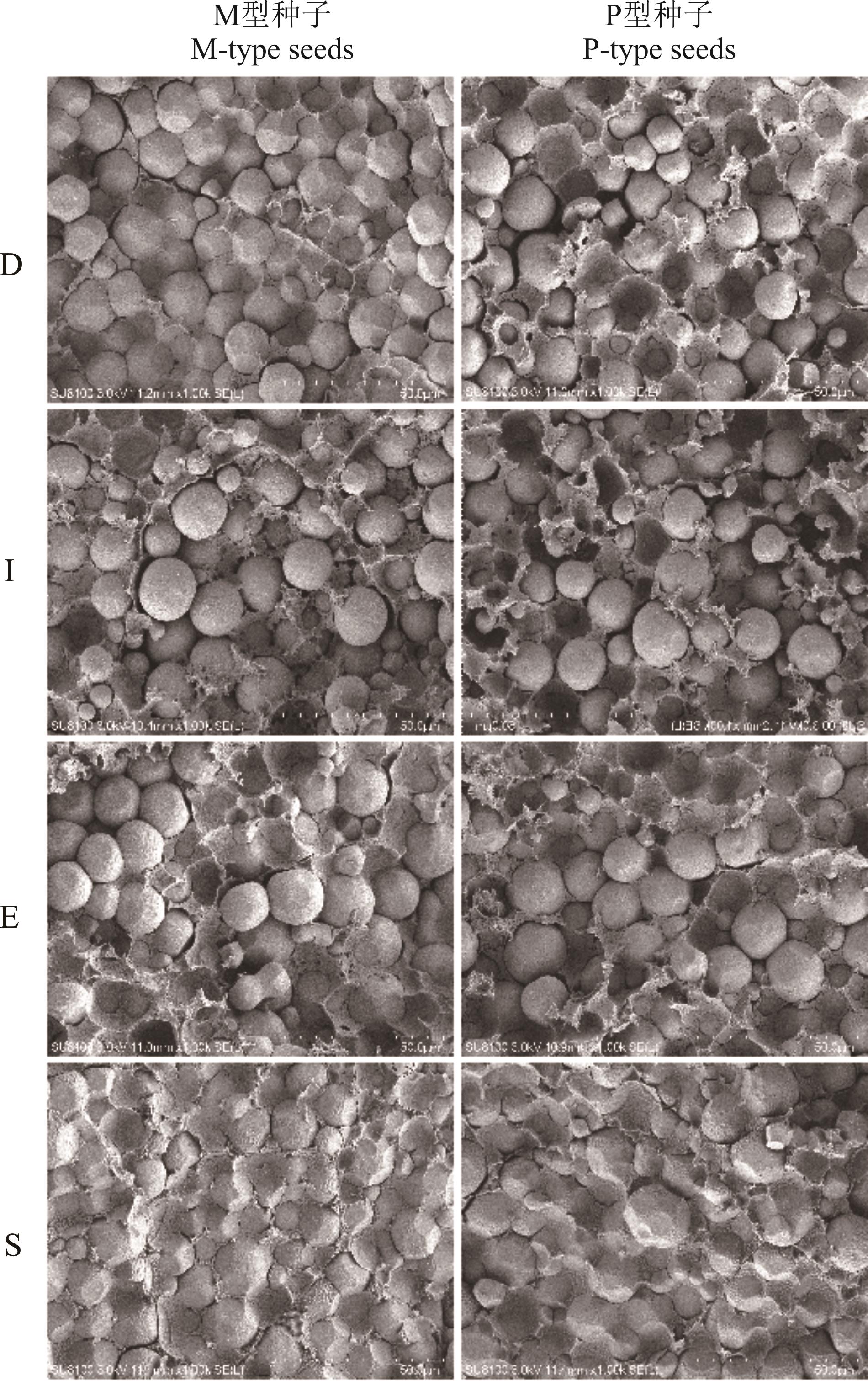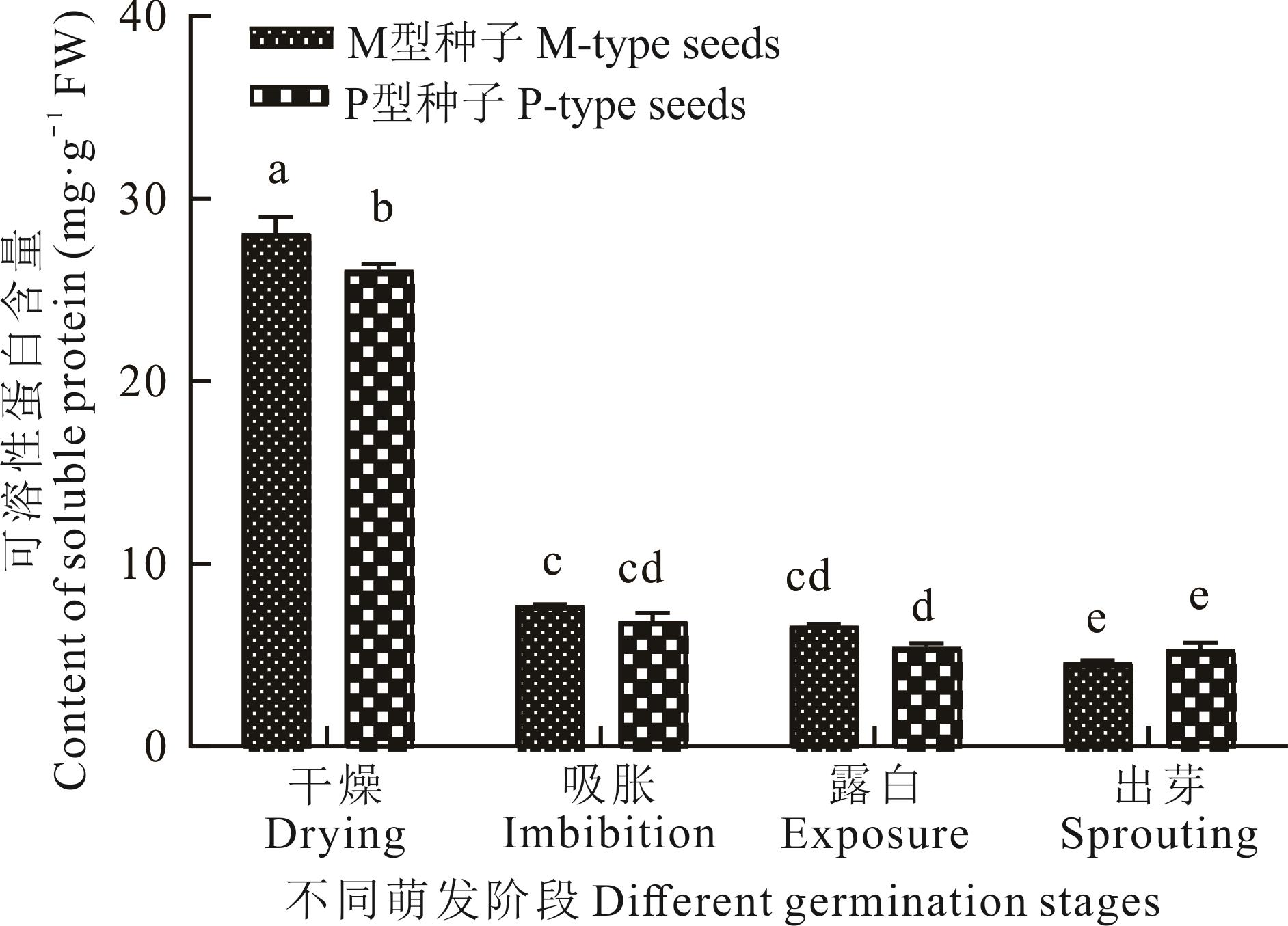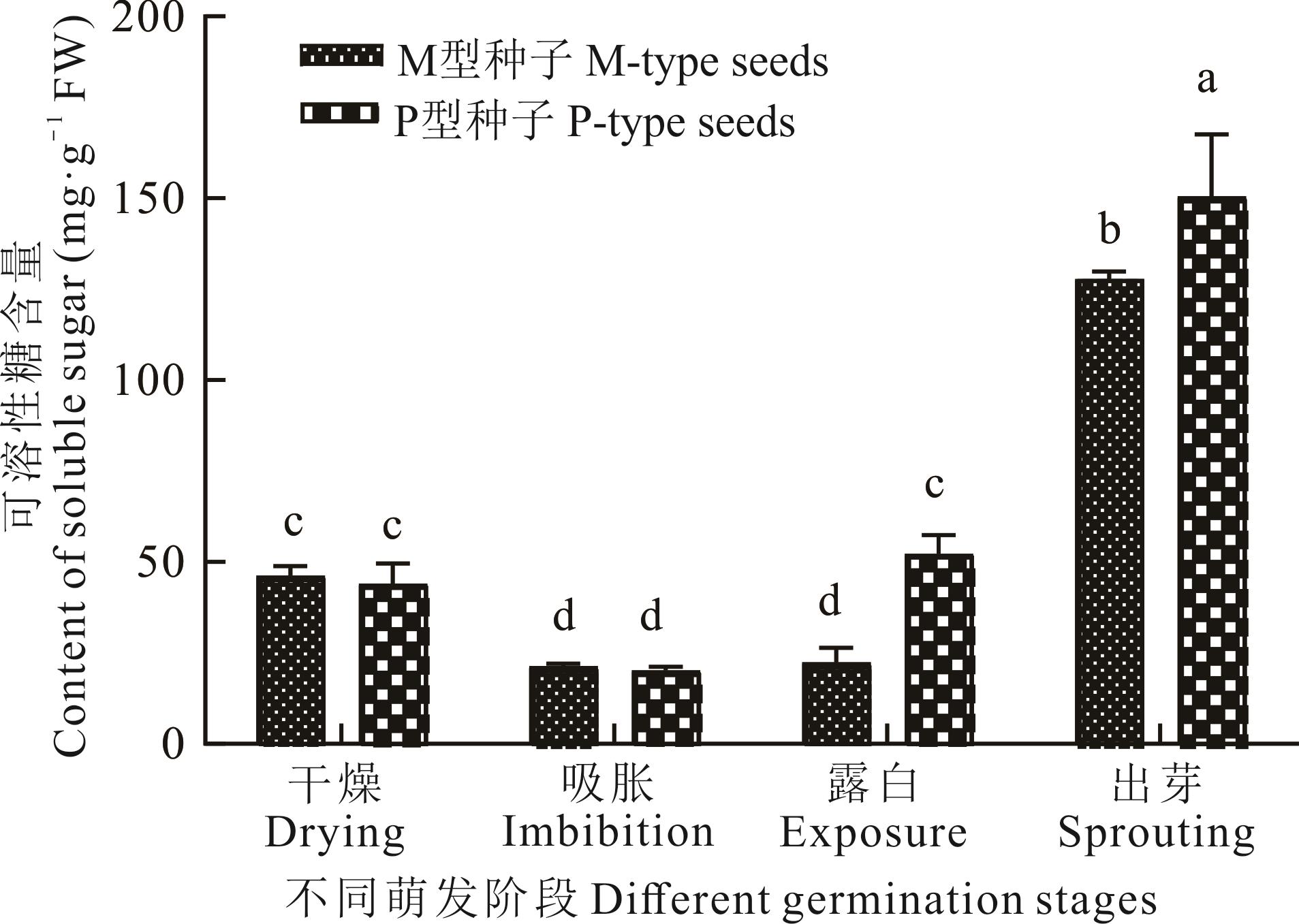

ISSN 1004-5759 CN 62-1105/S


草业学报 ›› 2024, Vol. 33 ›› Issue (9): 40-50.DOI: 10.11686/cyxb2023382
郝丽芬1( ), 徐晓阳1, 季玉1, 王瑞2, 吴德宝1,3, 李宇宇1(
), 徐晓阳1, 季玉1, 王瑞2, 吴德宝1,3, 李宇宇1( ), 林克剑1(
), 林克剑1( )
)
收稿日期:2023-10-11
修回日期:2023-11-16
出版日期:2024-09-20
发布日期:2024-06-20
通讯作者:
李宇宇,林克剑
作者简介:linkejian@caas.cn基金资助:
Li-fen HAO1( ), Xiao-yang XU1, Yu JI1, Rui WANG2, De-bao WU1,3, Yu-yu LI1(
), Xiao-yang XU1, Yu JI1, Rui WANG2, De-bao WU1,3, Yu-yu LI1( ), Ke-jian LIN1(
), Ke-jian LIN1( )
)
Received:2023-10-11
Revised:2023-11-16
Online:2024-09-20
Published:2024-06-20
Contact:
Yu-yu LI,Ke-jian LIN
摘要:
长刺蒺藜草刺苞内含有M型和P型两异型种子,两异型种子萌发具有异时性,是其适应异质性环境的策略。为了揭示导致两异型种子异时萌发的内在生理因素,本研究首先比较了两异型种子形态结构和萌发特性指标,同时测定了萌发过程中(干燥、吸胀、露白和出芽期)的生理指标。结果表明,长刺蒺藜草异型种子(M型、P型、刺苞内M型)千粒重、吸水量和萌发率的变化趋势为:刺苞内M型>M型>P型;含水量的变化趋势为:P型>M型>刺苞。P型种子比M型种子种皮致密,淀粉粒出现水解孔滞后,且水解孔更小;干燥期P型种子的脱落酸(ABA)含量显著高于M型种子,而露白期P型种子赤霉素(GA4)含量高于M型种子;M型种子可溶性蛋白含量在干燥、吸胀和露白阶段均高于P型种子;在萌发前期(干燥和吸胀期)两异型种子可溶性糖含量无显著差异,在露白和出芽期P型种子可溶性糖含量显著高于M型种子;干燥、吸胀和露白期M型种子葡萄糖-6-磷酸脱氢酶(G6PDH)活性显著高于P型种子,出芽期P型种子显著高于M型种子。综上所述,M型种子先于P型种子萌发,这与种皮结构、ABA/GA4、可溶性蛋白含量和G6PDH活性显著相关,与可溶性糖基础含量无关,M型种子和P型种子的内在萌发机制存在明显差异,可为制定长刺蒺藜草种子引发剂提供理论指导。
郝丽芬, 徐晓阳, 季玉, 王瑞, 吴德宝, 李宇宇, 林克剑. 长刺蒺藜草两异型种子形态和萌发过程的生理动态特征比较[J]. 草业学报, 2024, 33(9): 40-50.
Li-fen HAO, Xiao-yang XU, Yu JI, Rui WANG, De-bao WU, Yu-yu LI, Ke-jian LIN. Comparison of the dynamic morphological and physiological characteristics of twin seeds during the germination of field sandbur[J]. Acta Prataculturae Sinica, 2024, 33(9): 40-50.

图1 长刺蒺藜草异型种子和刺苞的形态特征a: 刺苞前面In front of the burs; b: 刺苞上面Above the burs; c: 种子背面(左为P型种子,右为M型种子) Back of the seed (left for P-type seed, right for M-type seed); d: 种子腹面(左为P型种子,右为M型种子) Seed ventral surface (P-type seed on the left, M-type seed on the right); e: M型种子种皮Seed coat of M-type seed; f: P型种子种皮Seed coat of P-type seeds.
Fig.1 Morphological characteristics of heteromorphic seeds and burs of C. longispinus
| 种子类型Seed types | 千粒重1000-grain weight (g) | 含水量Water content (%) | 萌发率Germination rate (%) |
|---|---|---|---|
| M型种子M-type seeds | 7.73±0.08b | 4.38±0.07a | 83.89±0.92b |
| P型种子P-type seeds | 4.50±0.09c | 4.42±0.07a | 56.72±1.73c |
| 刺苞内M型种子M-type seed in burs | 13.73±0.05a | 4.23±0.05a | 95.26±1.37a |
表1 M型种子、P型种子和刺苞种子的千粒重、含水量和萌发率测定
Table 1 Determination of 1000-grain weight, water content and germination rate of M-type seeds, P-type seeds and burs
| 种子类型Seed types | 千粒重1000-grain weight (g) | 含水量Water content (%) | 萌发率Germination rate (%) |
|---|---|---|---|
| M型种子M-type seeds | 7.73±0.08b | 4.38±0.07a | 83.89±0.92b |
| P型种子P-type seeds | 4.50±0.09c | 4.42±0.07a | 56.72±1.73c |
| 刺苞内M型种子M-type seed in burs | 13.73±0.05a | 4.23±0.05a | 95.26±1.37a |

图3 长刺蒺藜草M型种子和P型种子胚乳结构特征D:干燥Drying; I:吸胀Imbibition; E:露白Exposure; B:出芽Sprouting.
Fig.3 Endosperm structure of M-type and P-type seeds of C. longispinus during germination

图4 长刺蒺藜草异型种子(P型、M型)萌发过程中ABA和GA4含量的变化不同小写字母表示差异显著(P<0.05),下同。Different lowercase letters indicate significant differences (P<0.05), the same below.
Fig.4 Changes of ABA and GA4 content in heteromorphic seeds (P-type and M-type) of C. longispinus during germination

图5 长刺蒺藜草异型种子(P型、M型)萌发过程中可溶性蛋白含量的变化
Fig.5 Changes of soluble protein content in heteromorphic seeds (P-type and M-type) during germination of C. longispinus

图6 长刺蒺藜草异型种子(P型、M型)萌发过程中可溶性糖含量的变化
Fig.6 Changes of soluble sugar content in heteromorphic seeds (P-type and M-type) during germination of C. longispinus
| 1 | Du G M, Cao F Q, Liu W B, et al. The distribution and harmfulness of Cenchrus pauciflorus Benth. in Liaoning Province. Grassland of China, 1995(3): 71-73. |
| 杜广明, 曹凤芹, 刘文斌, 等. 辽宁省草场的少花蒺藜草及其危害. 中国草地, 1995(3): 71-73. | |
| 2 | Sun Z L, Shu Q, Gao K, et al. Invasion status, adaptation mechanism and control strategy of field sandbur: a review. Acta Agrestia Sinica, 2020, 28(5): 1196-1202. |
| 孙忠林, 淑琴, 高凯, 等. 少花蒺藜草入侵现状、适应机制和防控策略. 草地学报, 2020, 28(5): 1196-1202. | |
| 3 | Bao H, Fu J W, Wang Y F, et al. Monitoring and control of the occurrence of Cenchrus pauciflorus in Inner Mongolia. China Plant Protection, 2021, 41(12): 85-87. |
| 包菡, 傅建伟, 王跃飞, 等. 少花蒺藜草在内蒙古的发生监测与防治. 中国植保导刊, 2021, 41(12): 85-87. | |
| 4 | Zhou Q L, Wang Z W, Qi F L, et al. Biological and ecological characteristics of Cenchrus pauciflorus and the integrated control strategies. Chinese Journal of Ecology, 2021, 40(8): 2593-2600. |
| 周全来, 王正文, 齐凤林, 等. 少花蒺藜草生物生态学特征与综合防除策略. 生态学杂志, 2021, 40(8): 2593-2600. | |
| 5 | Xu J, Li Q F, Wang S Y, et al. Research on flowering behavior and seed germination of Cenchrus pauciflorus. Chinese Journal of Grassland, 2011, 33(2): 12-16. |
| 徐军, 李青丰, 王树彦, 等. 少花蒺藜草开花习性与种子萌发特性研究. 中国草地学报, 2011, 33(2): 12-16. | |
| 6 | Zhang Y L, Zhang R H, Fu W D, et al. Effects of different cultivation practices on the amount of seeds in the soils and seed production of Cenchrus pauciflorus Benth. Journal of Agricultural Resources and Environment, 2015, 32(3): 312-320. |
| 张衍雷, 张瑞海, 付卫东, 等. 不同农作措施对少花蒺藜草(Cenchrus pauciflorus Benth)种子库及其繁殖能力的影响. 农业资源与环境学报, 2015, 32(3): 312-320. | |
| 7 | Tian X, Zhang Z X, Chen Y D. Seed banks and seed structure characteristics of seed vigor of Cenchrus pauciflorus in Korqin Sandy Land. Chinese Journal of Grassland, 2015, 37(6): 85-90. |
| 田迅, 张志新, 陈艳东. 科尔沁沙地不同地区少花蒺藜草种子库与种子活力结构特征. 中国草地学报, 2015, 37(6): 85-90. | |
| 8 | Li G Y, Wang Y F. Discussion on characteristics and control measures of Cenchrus pauciflorus Benth in western Liaoning. Horticulture and Seed, 2013(9): 6-7, 25. |
| 李国英, 王宇飞. 辽西地区疏花蒺藜草特征特性及防治对策探讨. 园艺与种苗, 2013(9): 6-7, 25. | |
| 9 | Sorensen A E. Somatic polymorphism and seed dispersal. Nature, 1978, 276(5684): 174-176. |
| 10 | Alvarado V, Bradford K J. Hydrothermal time analysis of seed dormancy in true (botanical) potato seeds. Seed Science Research, 2005, 15(2): 77-88. |
| 11 | Wang L, Huang Z Y, Baskin C C, et al. Germination of dimorphic seeds of the desert annual halophyte Suaeda aralocaspica (Chenopodiaceae), a C4 plant without Kranz anatomy. Annals of Botany, 2008, 102: 757-769. |
| 12 | Wei Y, Dong M, Huang Z Y. Seed polymorphism, dormancy, and germination of Salsola affinis (Chenopodiaceae), a dominant desert annual inhabiting the Junggar Basin of Xinjiang, China. Journal of Plant Ecology, 2007, 55(4): 1046-1053. |
| 13 | Qu T, Zhou L Y. Seed germination strategy and seedling growth characteristics of heteromorphic seeds of the invasive weed Cenchrus incertus. Acta Prataculturae Sinica, 2022, 31(6): 91-100. |
| 曲婷, 周立业. 入侵植物少花蒺藜草异型种子萌发策略及其幼苗生长特性. 草业学报, 2022, 31(6): 91-100. | |
| 14 | Huo Y L, Qu T, Gao K, et al. Response of seed germination of different types of Cenchrus incertus to water and light. Journal of Anhui Agricultural Sciences, 2022, 50(4): 51-56. |
| 霍艳利, 曲婷, 高凯, 等. 不同类型的少花蒺藜草种子萌发对水分和光照的响应. 安徽农业科学, 2022, 50(4): 51-56. | |
| 15 | Zhang Z X, Tian X, Sun L. Germination behaviour of Cenchrus pauciflorus seeds across a range of salinities. Weed Research, 2017, 57(2): 91-100. |
| 16 | Howell K A, Narsai R, Carroll A, et al. Mapping metabolic and transcript temporal switches during germination in rice highlights specific transcription factors and the role of RNA instability in the germination process. Plant Physiology, 2008, 149(2): 961-980. |
| 17 | Qu B, Zhu M X, Wang W, et al. Effect of four kinds of environment factors on seed germination of Cenchrus pauciflorus Benth. Seed, 2011, 30(3): 28-30. |
| 曲波, 朱明星, 王巍, 等. 4种环境因子对少花蒺藜草(Cenchrus pauciflorus Benth.)种子萌发的影响. 种子, 2011, 30(3): 28-30. | |
| 18 | Liu L P, Ni H W, Xie Y Q. Seed germination and emergence characteristics of Cenchrus pauciflorus Benth. Weed Science, 2014, 32(4): 8-11. |
| 刘露萍, 倪汉文, 谢亚琼. 少花蒺藜草种子萌发与出苗特性. 杂草科学, 2014, 32(4): 8-11. | |
| 19 | Zhou L Y, Li J H, Ma F, et al. Study on seed germination characteristics of Cenchrus pauciflorus Benth. Journal of Inner Mongolia University for Nationalities (Natural Science Edition), 2013, 28(2): 203-205. |
| 周立业, 李建华, 马菲, 等. 少花蒺藜草种子发芽特性研究. 内蒙古民族大学学报(自然科学版), 2013, 28(2): 203-205. | |
| 20 | Liu Y. Study on the ecological characteristics and physiology and biochemistry activity for seed germination of Astraglus membranaceus. Changchun: Jilin Agricultural University, 2006. |
| 刘宇. 膜荚黄芪种子萌发生态特性及生理生化活性的研究. 长春: 吉林农业大学, 2006. | |
| 21 | He Z M, Yan F, Wang Q L, et al. Research on the biological characteristics of garlic seedling seeds. Agricultural Science-Technology and Information, 2021(6): 34-36, 42. |
| 何振明, 闫芳, 王勤礼, 等. 蒜苗种子生物学特性研究. 农业科技与信息, 2021(6): 34-36, 42. | |
| 22 | Li Y, Zhou C, Yan X, et al. Simultaneous analysis of ten phytohormones in Sargassum horneri by high-performance liquid chromatography with electrospray ionization tandem mass spectrometry. Journal of Separation Science, 2016, 39(10): 1804-1813. |
| 23 | Floková K, Tarkowská D, Miersch O, et al. UHPLC-MS/MS based target profiling of stress-induced phytohormones. Phytochemistry, 2014, 105: 147-157. |
| 24 | Cai B D, Zhu J X, Gao Q, et al. Rapid and high-throughput determination of endogenous cytokinins in Oryza sativa by bare Fe3O4 nanoparticles-based magnetic solid-phase extraction. Journal of Chromatography A, 2014, 1340: 146-150. |
| 25 | Niu Q, Zong Y, Qian M, et al. Simultaneous quantitative determination of major plant hormones in pear flowers and fruit by UPLC/ESI-MS/MS. Analytical Methods, 2014, 6(6): 1766-1773. |
| 26 | Xiao H M, Cai W J, Ye T T, et al. Spatio-temporal profiling of abscisic acid, indoleacetic acid and jasmonic acid in single rice seed during seed germination. Analytica Chimica Acta, 2018, 10(31): 119-127. |
| 27 | Pan X, Welti R, Wang X. Quantitative analysis of major plant hormones in crude plant extracts by high-performance liquid chromatography-mass spectrometry. Nature Protocols, 2010, 5(6): 986-992. |
| 28 | Šimura J, Antoniadi I, Široká J, et al. Plant hormonomics: Multiple phytohormone profiling by targeted metabolomics. Plant Physiology, 2018, 177(2): 476-489. |
| 29 | Cui K, Lin Y, Zhou X, et al. Comparison of sample pretreatment methods for the determination of multiple phytohormones in plant samples by liquid chromatography-electrospray ionization-tandem mass spectrometry. Microchemical Journal, 2015, 1(21): 25-31. |
| 30 | Wang X K. Experimental principles and techniques of plant physiology and biochemistry. Beijing: Higher Education Press, 2006. |
| 王学奎. 植物生理生化实验原理和技术. 北京: 高等教育出版社, 2006. | |
| 31 | Thomson F J, Moles A T, Auld T D, et al. Chasing the un-known: Predicting seed dispersal mechanisms from plant traits. Journal of Ecology, 2010, 98(6): 1310-1318. |
| 32 | Wu T L, Xiao B X, Zheng Q Y, et al. Effect of harvest times on seed quality of Kengyilia rigidula cv. Aba. Prataculture & Animal Husbandry, 2016(2): 33-38. |
| 吴通来, 肖冰雪, 郑群英, 等. 收获期对“阿坝”硬秆仲彬草种子质量的影响. 草业与畜牧, 2016(2): 33-38. | |
| 33 | Zhu M J, Huang J H, Yang W Y, et al. Study on seed morphological dormancy characteristics in Fritillaria yuminensis X. Z. Duan. Northern Horticulture, 2019(21): 109-117. |
| 朱敏嘉, 黄俊华, 杨文英, 等. 裕民贝母种子形态休眠特性研究. 北方园艺, 2019(21): 109-117. | |
| 34 | Lin S X, Li M Q. Basic knowledge of crop physiology-seed germination physiology. Guangdong Agricultural Science, 1982(1): 47-50. |
| 林韶湘, 李明启. 作物生理基础知识(一)-种子萌发生理. 广东农业科学, 1982(1): 47-50. | |
| 35 | Bradford K J. A water relations analysis of seed germination rates. Plant Physiology, 1990, 94(2): 840-849. |
| 36 | Le Page-Degivry M T, Barthe P, Garello G. Involvement of endogenous abscisic acid in onset and release of Helianthus annuus embryo dormancy. Plant Physiology, 1990, 92(4): 1164-1168. |
| 37 | Gulden R H, Chiwocha S, Abrams S, et al. Response to abscisic acid application and hormone profiles in spring Brassica napus seed in relation to secondary dormancy. Canadian Journal of Botany, 2004, 82(11): 1618-1624. |
| 38 | Jacobsen J V, Pearce D W, Poole A T, et al. Abscisic acid, phaseic acid and gibberellin contents associated with dormancy and germination in barley. Physiologia Plantarum, 2002, 115(3): 428-441. |
| 39 | Wu S B. Characteristics of spectra in fluorimetry for GA3. Plant Physiology Communications, 1990(4): 56-58. |
| 吴少伯. 赤霉素荧光测定的光谱特征. 植物生理学通讯, 1990(4): 56-58. | |
| 40 | Zhang X Y. Changes of hormones in carrot seeds during germination. Nanjing: Nanjing Agricultural University, 2017. |
| 张馨月. 胡萝卜种子萌发过程中激素的变化规律. 南京: 南京农业大学, 2017. | |
| 41 | Peng F R, Guo J, Xu B S, et al. Progresses of research on vegetative storage proteins in woody plants. Chinese Bulletin of Botany, 2001, 18(4): 445-450. |
| 彭方仁, 郭娟, 徐柏森, 等. 木本植物营养贮藏蛋白质研究进展. 植物学通报, 2001, 18(4): 445-450. | |
| 42 | Sheikh M B. The component of soluble sugar in peanut. Journal of Agricultural and Food Chemistry, 2001, 40(5): 780-783. |
| 43 | Zhu Q S, Wang Y S, Lin G Q, et al. Glycochemistry. Beijing: Science Press, 2005. |
| 朱清时, 汪元生, 林国强, 等. 糖化学. 北京: 科学出版社, 2005. | |
| 44 | Liu Z H, Dong Y, Lu B S. Preliminary studies on storage substance content during the germination of Pistacia vera seeds. Seed, 2002(6): 28-30. |
| 刘忠华, 董源, 路丙社. 阿月浑子种子萌发过程中贮藏物质含量的初步研究. 种子, 2002(6): 28-30. | |
| 45 | Qin L, Dong Q H, Wang Y N, et al. The change of carbohydrate in germinating of Chinese chestnut seeds. Journal of Beijing Agricultural College, 1995, 2(10): 53-57. |
| 秦岭, 董清华, 王有年, 等. 板栗种子萌发过程中碳水化合物的变化. 北京农学院学报, 1995, 2(10): 53-57. | |
| 46 | Shang J, Wang W Z, Zhao K T, et al. Organic substance metabolism during seed germination of Pinus bungeana. Journal of Northeast Forestry University, 1992, 20(2): 24-29. |
| 尚杰, 王文章, 赵垦田, 等. 白皮松种子萌发过程中有机质代谢的研究. 东北林业大学学报, 1992, 20(2): 24-29. | |
| 47 | Dong X H, Wan Q L, Xu N, et al. Study on the change of physiology and biochemistry during process of carrot seed germination. Biotechnology, 2005, 15(6): 55-57. |
| 董晓红, 万清林, 徐娜, 等. 胡萝卜种子萌发过程中生理生化变化的研究. 生物技术, 2005, 15(6): 55-57. | |
| 48 | Hou F Y. Cloning and functional analysis of two key enzyme genes in pentose phosphate pathway from rice (Oryza Sativa L.). Nanjing: Nanjing Agricultural University, 2005. |
| 候夫云. 水稻戊糖磷酸途径两个关键酶基因的克隆与功能分析. 南京: 南京农业大学, 2005. | |
| 49 | Zhao Y H, Yang S L, Liu H Q, et al. Relationship between phosphopentose pathway and seed dormancy releasing of Panax quinquefolius. Chinese Traditional and Herbal Drugs, 2001, 32(3): 259-261. |
| 赵永华, 杨世林, 刘惠卿, 等. 西洋参种子休眠解除与磷酸戊糖途径关系的研究. 中草药, 2001, 32(3): 259-261. |
| [1] | 高金柱, 赵东豪, 高乐, 苏喜浩, 何学青. 硝酸铈与脱落酸处理对紫花苜蓿种子萌发和幼苗生理特性的影响[J]. 草业学报, 2024, 33(6): 175-186. |
| [2] | 张适阳, 刘凤民, 崔均涛, 何磊, 冯月燕, 张伟丽. 三种外源物质对低温胁迫下柱花草生理与荧光特性的影响[J]. 草业学报, 2023, 32(6): 85-99. |
| [3] | 赵金梅, 殷国梅, 孙娟娟, 卫媛, 李薇, 郭茂伟, 刘思齐, 张佳琪. 抗寒锻炼中紫花苜蓿非结构性碳水化合物转化转运与抗寒性关系[J]. 草业学报, 2023, 32(12): 181-188. |
| [4] | 赵利清, 郝志刚, 崔笑岩, 彭向永. 赤霉素及其抑制剂调控草地早熟禾生长及赤霉素相关基因表达的研究[J]. 草业学报, 2022, 31(3): 85-91. |
| [5] | 李振松, 万里强, 李硕, 李向林. 苜蓿根系构型及生理特性对干旱复水的响应[J]. 草业学报, 2021, 30(1): 189-196. |
| [6] | 项洪涛, 郑殿峰, 何宁, 李琬, 王曼力, 王诗雅. 植物对低温胁迫的生理响应及外源脱落酸缓解胁迫效应的研究进展[J]. 草业学报, 2021, 30(1): 208-219. |
| [7] | 崔雪莲, 夏超. 外源脱落酸对醉马草内生真菌共生体幼苗建植过程的影响[J]. 草业学报, 2020, 29(7): 70-80. |
| [8] | 衣琨, 赵一航, 胡尧, 刘佳雪, 贺涛涛, 李旭, 宋鹏, 崔国文, 殷秀杰. GA3和6-BA对高加索三叶草根蘖芽生长及内源激素含量的影响[J]. 草业学报, 2020, 29(2): 22-30. |
| [9] | 王宁, 付亚军, 袁美丽, 刘征阳, 张铭鑫, 米银法. GA3浸种对入侵植物节节麦种子破眠及发芽特性的影响[J]. 草业学报, 2020, 29(2): 73-81. |
| [10] | 程守丰, 梁巧兰, 魏列新, 桑旭文, 姜玉玲. 苜蓿不同品种AMV和WCMV带毒检测及生理生化特性研究[J]. 草业学报, 2020, 29(12): 140-149. |
| [11] | 伍国强, 李辉, 雷彩荣, 蔺丽媛, 金娟, 李善家. 添加KCl对高盐胁迫下红豆草生长及生理特性的影响[J]. 草业学报, 2019, 28(6): 45-55. |
| [12] | 高亚敏, 姚拓, 李海云, 罗慧琴, 张建贵, 杨琰珊, 刘婷. 高寒草甸嵩草、珠芽蓼根际优良植物根际促生菌的分离筛选及促生特性研究[J]. 草业学报, 2019, 28(11): 114-123. |
| [13] | 任胜茂, 邓榆川, 文凤君, 刘明洁, 袁小琴, SajadHussain, 蒲全明, 刘卫国, 杨文钰. 套作对大豆苗期碳氮物质代谢的影响及其与抗倒伏性的关系[J]. 草业学报, 2018, 27(9): 85-94. |
| [14] | 刘伯帅, 王文静, 孙骁, 李德锋, 朱晓艳, 李振田, 王成章, 史莹华, 邱晓东. 饲粮纤维源对仔猪生长性能、肠道发育及其消化酶活性的影响[J]. 草业学报, 2018, 27(9): 175-182. |
| [15] | 熊丽丽, 闫霜, 李萍, 杨国柱, 尹卫, 严晓霞, 张韩. 葡萄糖-6-磷酸脱氢酶在紫花苜蓿干旱耐受性中的响应[J]. 草业学报, 2018, 27(2): 48-56. |
| 阅读次数 | ||||||
|
全文 |
|
|||||
|
摘要 |
|
|||||